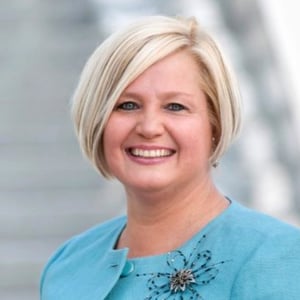A Side of Radiology You Rarely See
Unfamiliar to many rising and practicing radiologists, its impact is profound in the world of imaging for diagnosis and treatment planning.
Read more
ACR leadership believes it is critical to work with and support ACR state chapters in their advocacy work through legislative, regulatory and administrative action. The College has chapters in all 50 states, the District of Columbia, Puerto Rico and Canada as well as representation from the Council of Affiliated Regional Radiation Oncology Societies. Chapters provide members with structured, organized opportunities to attend local meetings, connect with fellow radiologists and advocate for the specialty at a grassroots level.
Chapters also offer resources for continuing education and understanding shifting economic policies — and members have opportunities to shape ACR national policy and procedures through the ACR Council, providing input for ACR policy and Practice Parameters and Technical Standards.
While the impact of changes put in place by the Trump administration on healthcare remains unclear, state lawmakers are not waiting to tackle hot-button issues that directly or indirectly affect radiologists and the patients they serve. Last month, the Bulletin spoke with leaders from two chapters working on state issues including political action committees (PACs), building stronger relationships with state lawmakers, and recruiting and retaining members. The following conversations illustrate the difficult tasks facing our state radiology associations — and why their efforts are so important.
 “Like many organizations, PARAD is faced with potentially shrinking membership numbers, which can impact revenue generated through dues for its programs,” says Judith (Judy) A. Eschberger, Esq., executive director of PARAD.
“Like many organizations, PARAD is faced with potentially shrinking membership numbers, which can impact revenue generated through dues for its programs,” says Judith (Judy) A. Eschberger, Esq., executive director of PARAD.
“During the last three election cycles, widespread turnover in the Pennsylvania General Assembly and the costs associated with reelecting members, maintaining and reelecting legislators we’ve already spent time educating — and who have become advocates for our issues — is always a top priority,” Eschberger says. “We decided to work with other physician groups whose issues did not conflict with PARAD. We want to pool our resources and build relationships with first-year members of the General Assembly as a first step in educating them on our issues.”
Establishing relationships with legislators requires time, resources and commitment. “One dinner or social encounter with a legislator is not going to cement those relationships,” Eschberger says. To help the chapter navigate state government, PARAD retained a government relations professional to work on its behalf to maintain and grow relationships. “We are looking for opportunities to interact with legislators and be a resource for them as they make decisions on legislation that affect our practice and healthcare throughout the Commonwealth,” she explains.
“The government relations community, along with our clients — namely nonprofits and corporations who work to educate state legislators and serve as a resource to them as they consider legislation — are being asked to help raise money for reelection,” Eschberger says. Areas of the Commonwealth with the largest population centers — southeastern Pennsylvania, including Philadelphia and surrounding counties, and the Lehigh Valley bordering New Jersey — face more expensive TV ad time during an election cycle, she notes. “As a result, the pressure on candidates’ campaign committees to raise money is incredible, and it trickles down to those working to educate Senate and House members who serve on committees tied to impactful issues for radiologists and the healthcare system as a whole.”
Some examples of legislation on the chapter’s radar include: an amendment to Act 112 of 2018, addressing vague language around patient notification of a “significant abnormality” and clarifying provisions advising patients at the time of their procedure that results will be available to them via their referring clinician’s patient portal; RT licensing legislation, which is combined with other licensing proposals for other specialties; and legislation requiring insurance companies to cover all costs associated with imaging for breast cancer.
Along with shrinking reimbursements for services, our radiologists face increasing medical malpractice insurance rates, underscoring the need for tort reform and the elimination of venue shopping.
“Along with shrinking reimbursements for services, our radiologists face increasing medical malpractice insurance rates, underscoring the need for tort reform and the elimination of venue shopping,” Eschberger says. “When Pennsylvania enacted a special venue rule directing medical malpractice claimants to file such claims ‘only in a county in which the cause of action arose,’ medical malpractice claims filed in Philadelphia fell on average from 1,204 to 577,” she says. “However, Pennsylvania’s healthcare industry is once again feeling the negative effects of venue shopping after the Pennsylvania Supreme Court’s decision to eliminate the special venue rule for medical malpractice cases in the Commonwealth.” Not surprisingly, there has been a large uptick in cases filed within the state high court’s jurisdiction since the rule was rescinded.
“We must remain diligent on this and other issues,” Eschberger says. “Local- and state-level efforts are the first fields that should be cultivated; encouraging robust participation at the local and state levels will strengthen the growth of PARAD and ACR.”
 Educating state lawmakers and regulators on the issues impacting radiology and related medical specialties has been a primary focus of the MRS. “National politics may steal the media spotlight and overshadow state legislatures, but we know local politics has an outsized impact on our day-to-day and professional lives,” says Anne Reddy, MD, FACR, a vascular and interventional radiologist and president of the MRS. “We anticipate that state representatives may become even more pivotal in healthcare legislation this year given the current national political environment.”
Educating state lawmakers and regulators on the issues impacting radiology and related medical specialties has been a primary focus of the MRS. “National politics may steal the media spotlight and overshadow state legislatures, but we know local politics has an outsized impact on our day-to-day and professional lives,” says Anne Reddy, MD, FACR, a vascular and interventional radiologist and president of the MRS. “We anticipate that state representatives may become even more pivotal in healthcare legislation this year given the current national political environment.”
“Although radiologists have made strides in increasing public awareness of our specialty, there are still perception gaps about our role in patient care,” Reddy says. “Our chapter is committed to bridging these gaps with legislators by taking opportunities to meet with them, explaining exactly how we serve patients and stressing that radiologists want to be part of the solution.”
“Our members have had many meaningful discussions with our representatives at state chapter and executive council meetings,” Reddy says. “Any opportunity for one-on-one personal interactions with individual legislators is a chance to solidify relationships. These relationships have proven useful in previous legislative frays, ranging from scope of practice to pre-authorization.”
The MRS also coordinates a yearly “Day at the Capitol” that mirrors the event at ACR’s annual meeting. “There is a call to action sent out to our members and we create talking points around advocacy issues,” Reddy says. “The appointments with legislators are coordinated by our lobbyists, who also contact the representatives prior to the meetings to review our concerns. The attendees have a pre-meeting review session to discuss talking points and a post-meeting debrief session to discuss results.”
Other MRS interactive events with local representatives allow members to share concerns and, more importantly, to share their stories. “Our narratives are intertwined with those of our patients and our representatives,” Reddy says. “I recently attended a social hour and pressed legislators about the onerous burden of the imaging pre-authorization process. I shared the frustration of one of my patients, a young mother, who was trying to navigate the insurance system as she sought treatment options for her metastatic breast cancer. Her story struck a chord with many of the lawmakers, who shared their own frustrating experiences with a bewildering pre-authorization process that contributes to an inhospitable insurance climate,” she says.
The MRS will continue to advocate for radiologists and their patients through local actions, whether through events like “Day at the Capitol,” direct engagement with elected representatives or backing policies that protect radiologists and the specialty. “We will continue to work with the Minnesota Medical Association (MMA) to support mutually beneficial priorities, including supporting increasing medical assistance [Minnesota’s Medicaid program] and Minnesota Care payments. We are also committed to continued coverage for audio-only telehealth services,” Reddy says.
It is going to be a busy year for MRS. Despite being designated “Medical Alley” and having one of the largest health-technology clusters in the world, Minnesota still faces the same workforce issues most states are struggling to address. “Overcoming obstacles to recruiting young radiologists is one of our goals,” Reddy says. “We also plan to participate in the MMA Task Force on AI and to work with the Minnesota Society of Radiologic Technologists in its quest for independent state licensure for radiologic technologists. Independently, we will advocate for less burdensome imaging pre-authorization and assist our members in meeting new state-issued imaging price-transparency rules. Private-equity and scope-of-practice issues are also on our radar.”
The Bulletin will track and highlight the work of other ACR chapters throughout the remainder of the year and beyond. Up next: Connecticut and Hawaii. Get news, leadership updates and chapter meeting schedules for all ACR chapters through acr.org, which has a host of member resources to help you get engaged.
Stay on top of the issues that matter most to you, your practice and your patients each month with the Bulletin — including workforce complexities, scope-of-practice laws, reimbursement models, practice consolidation and tailoring AI to meet your needs. Follow the Bulletin on X (@ACRBulletin) and please send questions or comments about this article to chudnall@acr.org.
By Chad Hudnall, senior writer, ACR Press
A Side of Radiology You Rarely See
Unfamiliar to many rising and practicing radiologists, its impact is profound in the world of imaging for diagnosis and treatment planning.
Read more
JACR: Advancing Radiology Through Education and Training
The newest focus issue of the journal provides insight into equipping trainees with the knowledge and skills needed to succeed in the current healthcare environment.
Read more
Mammography Monday
The College is working with members of Congress from both sides of the aisle to promote breast cancer screening.
Read more